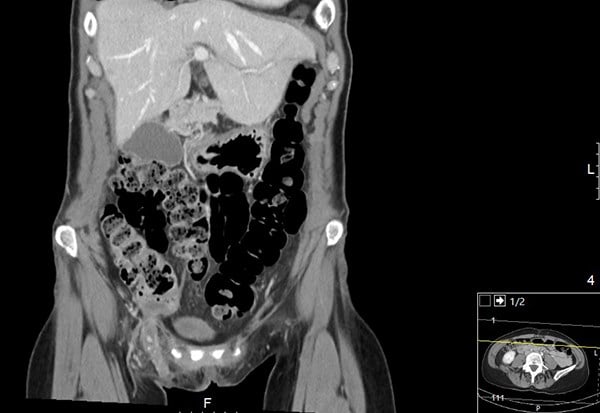Abdominal hernias are defined as a defect in the abdominal wall that allows part of or all of an organ to protrude beyond the natural abdominal barrier.
In 2016 there were 293,000 ED visits for abdominal hernias. In 2004, groin hernias were the third leading cause of gastrointestinal visits, with inguinal hernias being the most common. Inguinal hernias are mostly asymptomatic until they become incarcerated and/or strangulated. Symptoms of an incarcerated/strangulated hernia include a painful bulge or swelling, abdominal pain, nausea, vomiting, and fever. Once strangulation occurs, best outcomes are achieved when emergent surgery is done to relieve the ischemia in 4-6 hours.
Case
A 60-year-old female presents with sudden onset right groin pain that woke her from sleep at 2:30 am, approximately 10.5 hours prior to arrival. She reports associated nausea and vomiting. She denies fevers, chills, chest pain, shortness of breath, back pain, changes in urination/defecation, or vaginal discharge/bleeding. Upon further history the patient states she had a right femoral hernia repair almost three years ago and the pain feels similar. When asked why she waited so long to come to the ED, she stated she had a doctor’s appointment for an unrelated issue earlier in the day and didn’t want to miss it.
Physical exam is notable for tachycardia and acute discomfort. There is a severely tender bulge in the right groin just medial to the inguinal ligament that cannot be reduced with manual manipulation.
Abdominal and pre-op labs, urinalysis, and CT abdomen/pelvis with contrast were ordered for further evaluation. Morphine, ondansetron, and fluids were also given. Blood work was significant for mild leukocytosis. The CT results were available approximately 12 hours after symptom onset and showed acute appendicitis within a recurrent right inguinal hernia, also called Amyand's hernia.
General surgery was consulted and the patient was taken to the operating room a few hours later where her appendix was reduced out of the hernia and then resected. I spoke with the surgeon who performed the appendectomy who stated there may have been more complications if the patient's primary hernia repair had been done with mesh. He had never personally seen an Amyand's hernia before. At follow-up 2 weeks later the patient was doing well and hernia repair was scheduled 4 weeks later.
Discussion
Amyand's hernia is defined as an appendix that is contained within an inguinal hernia. The rate of the appendix being found within an inguinal hernia has been noted to be about 1%. Of the 1%, the appendix has been found to be inflamed in just 0.1%. In most cases they present with signs and symptoms of an incarcerated or strangulated hernia. Several theories about the etiology of Amyand's hernia have been hypothesized. The theory with the most support suggests that compression of the appendiceal neck within the hernia itself causes the ischemia and inflammation. Interestingly, Amyand's hernia is up to three times more common in children due to the processus vaginalis being patent.
Amyand's hernia is named after the French surgeon Claudius Amyand who is thought to have performed the first appendectomy that was contained within an inguinal hernia. In 1735, he performed surgery on an 11-year old boy who had presented with a right inguinal hernia only to find the appendix trapped within the hernia.
One study found Amyand's hernia exclusively in males on the right side; another study found some cases in females but they were exclusively in postmenopausal patients. Despite these studies there have been documented cases on the left side due to causes like situs inversus or a mobile cecum. Evidence of appendicitis within a hernia can be seen on both ultrasound and CT. However, most cases are found incidentally in the operating room during hernia repair.
Take-Home Points
- Strangulated hernias require surgical repair within 4-6 hours.
- Acute appendicitis within an inguinal hernia is a very rare cause of groin pain.
- Amyand's hernia can occur in all ages and genders.
References
- Cano G, Gasperin M, Pelaez H, Hernandez Z, Montiel J, Cravioto F. Amyand’s hernia and complicated appendicitis; case presentation and surgical treatment choice. 2016;84(1):54-7.
- Singal R, Gupta S. Amyand’s Hernia – Pathophysiology, Role of Investigations and Treatment. 2011;6(4):321-327.
- Brooks D, Hawn M. Classification, clinical features, and diagnosis of inguinal and femoral hernias in adults. 2019.
- Ivashchuk G, Cesmebasi A, Sorenson E, Blaak C, Tubbs S, Loukas M. Amyand's hernia: A review. Medical Science Monitor. 2014;20:140-146.
- Centers for Disease Control & Prevention. National Hospital Ambulatory Medical Care Survey: 2016 Emergency Department Summary Tables. 2016.



